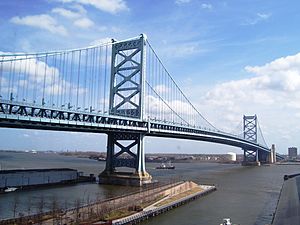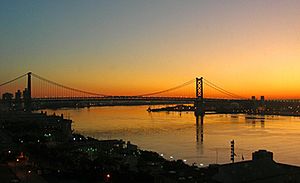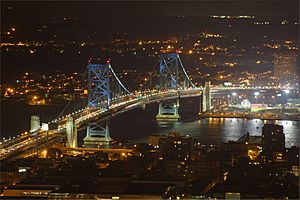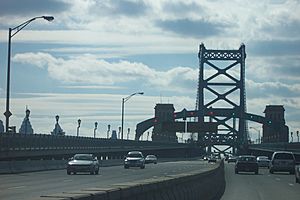Benjamin Franklin Bridge facts for kids
Quick facts for kids Benjamin Franklin Bridge |
|
|---|---|

The bridge in 2012, before the PATCO track was replaced. Race Street Pier is in the foreground.
|
|
| Coordinates | 39°57′11″N 75°08′02″W / 39.953°N 75.134°W |
| Carries | 7 lanes of |
| Crosses | Delaware River |
| Locale | Philadelphia, Pennsylvania to Camden, New Jersey |
| Official name | Benjamin Franklin Bridge |
| Other name(s) | Ben Franklin Bridge |
| Maintained by | Delaware River Port Authority of Pennsylvania and New Jersey |
| ID number | 4500010 |
| Characteristics | |
| Design | Steel suspension bridge |
| Total length | 2,917.86 meters (9,573.0 ft) |
| Width | 39.01 m (128.0 ft) |
| Height | 385 ft (117 m) |
| Longest span | 533.4 m (1,750 ft) |
| Clearance above | 5.12 m (16.8 ft) |
| Clearance below | 41.19 m (135.1 ft) |
| History | |
| Construction cost | $37,103,765 |
| Opened | July 1, 1926 (94 years ago) |
| Statistics | |
| Daily traffic | 100,000 |
| Toll | Cars $5.00; Trucks over 7,000 lbs $7.50/axle; Buses $3.75/axle (westbound into PA) (E-ZPass) |
|
Philadelphia Register of Historic Places
|
|
| Official name: Benjamin Franklin Bridge over the Delaware River | |
| Designated: | December 12, 2003 |
| Approximate Address: | 200 N 05th St |
The Benjamin Franklin Bridge is a famous suspension bridge that connects Philadelphia, Pennsylvania, and Camden, New Jersey. It is also known as the Delaware River Bridge or simply the Ben Franklin Bridge. This important bridge crosses the Delaware River.
It is one of four main bridges that link Philadelphia with southern New Jersey. The Delaware River Port Authority owns and manages it. The bridge carries Interstate 676 and U.S. Route 30. It also has paths for people walking and tracks for the PATCO Speedline train.
The bridge opened in 1926 as part of the Sesquicentennial Exposition. This event celebrated 150 years since the United States Declaration of Independence was signed. For three years, from 1926 to 1929, it was the longest single-span suspension bridge in the world!
Contents
History of the Ben Franklin Bridge
People started thinking about building a bridge across the Delaware River as early as 1818. They wanted a bridge to help people cross, instead of just using ferries. But serious plans did not begin until the 1910s. The Delaware River Bridge Joint Commission was formed in 1919 to make the bridge happen. This group is now called the Delaware River Port Authority.
Building the Bridge
Work on the bridge began on January 6, 1922. The main engineer was Ralph Modjeski, who was from Poland. Leon Moisseiff was the design engineer, and Paul Philippe Cret was the supervising architect. At its busiest, about 1,300 people worked on the bridge. Sadly, 15 workers lost their lives during its construction.
The bridge officially opened on July 1, 1926. This was three days earlier than planned, just before the nation's 150th anniversary. When it was finished, its main span was 1,750 feet (533 meters) long. This made it the longest suspension bridge in the world at that time. It held this record until the Ambassador Bridge opened in 1929.
Name Change and Anniversaries
The bridge was originally called the Delaware River Bridge. In 1955, its name was changed to the "Benjamin Franklin Bridge." This happened because another suspension bridge, the Walt Whitman Bridge, was being built nearby.
On July 1, 2001, the bridge was closed to cars. This allowed people to walk across it and celebrate its 75th anniversary.
How the Bridge is Used
The Benjamin Franklin Bridge is very busy. It helps many people travel between Philadelphia and New Jersey every day.
Train Tracks
When the bridge first opened, it had six lanes for cars. It also had two tracks for streetcars. There were even plans for rapid transit train tracks on the outer sides. However, the streetcar tracks were never used. The company that owned the streetcars stopped using them in 1932. After that, the tracks were removed, and the space was turned into more lanes for cars.
The rapid transit tracks, however, did open in 1936. This was for the Bridge Line subway, which connected Camden and Philadelphia. Today, these tracks carry the PATCO Speedline trains. These trains go into tunnels on both sides of the bridge. The train tracks and their support structures were rebuilt between June and October 2014.
Roads and Highways
The bridge carries two important highways: I-676 and US 30. These roads help connect different areas. While I-676 is signed across the bridge from both sides, the section on the Pennsylvania side is not quite up to full interstate highway standards. This is to make it less confusing for drivers.
"Zipper" Barrier
The bridge has seven lanes for vehicles. These lanes are separated by a special concrete barrier called a "zipper" barrier. This barrier can be moved by a machine. This allows the bridge operators to change how many lanes go in each direction. For example, during morning rush hour, four lanes might go towards Philadelphia and three towards New Jersey. In the evening, this can be reversed.
Lights on overhead signs tell drivers which lanes are open or closed. These lights help manage traffic and keep drivers safe. Before the zipper barrier was put in place around 2000-2001, one lane was often closed during busy times. This was to prevent head-on crashes, as there was no physical barrier between traffic going opposite ways.
Tolls
Drivers usually pay a toll when they travel westbound into Pennsylvania.
- Cars and small vehicles (under 7,000 pounds) pay $5.00.
- Larger vehicles like trucks and commercial vehicles pay $7.50 per axle.
- Seniors aged 65 and older can get a discount and pay $2.50 per trip using E-ZPass.
Walkways
The Benjamin Franklin Bridge has walkways on both sides. These paths are raised above the car lanes and are separate from them. Usually, only one walkway is open at a time for safety.
Sometimes, the walkways are closed for security reasons. For example, they were closed after the 2005 London bombings. They also close if there is snow or if bad weather like a hurricane is expected. This happened during Hurricane Irene in 2011 and Hurricane Sandy in 2012.
Images for kids
See also
 In Spanish: Puente Benjamin Franklin para niños
In Spanish: Puente Benjamin Franklin para niños





